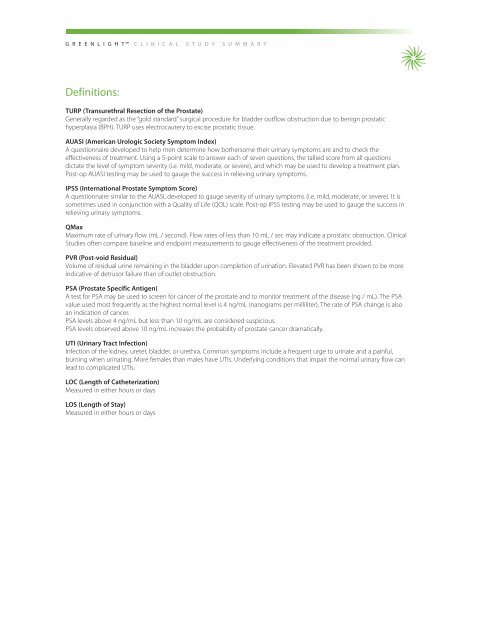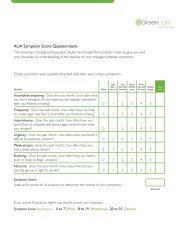C L I N I C A L S T U D Y S U M M A R Y
C L I N I C A L S T U D Y S U M M A R Y
C L I N I C A L S T U D Y S U M M A R Y
- No tags were found...
Create successful ePaper yourself
Turn your PDF publications into a flip-book with our unique Google optimized e-Paper software.
151557_GreenLightSummary_B 5/31/07 4:29 PM Page 2G R E E N L I G H TC L I N I C A L S T U D Y S U M M A R YDefinitions:TURP (Transurethral Resection of the Prostate)Generally regarded as the “gold standard” surgical procedure for bladder outflow obstruction due to benign prostatichyperplasia (BPH). TURP uses electrocautery to excise prostatic tissue.AUASI (American Urologic Society Symptom Index)A questionnaire developed to help men determine how bothersome their urinary symptoms are and to check theeffectiveness of treatment. Using a 5-point scale to answer each of seven questions, the tallied score from all questionsdictate the level of symptom severity (i.e. mild, moderate, or severe), and which may be used to develop a treatment plan.Post-op AUASI testing may be used to gauge the success in relieving urinary symptoms.IPSS (International Prostate Symptom Score)A questionnaire similar to the AUASI, developed to gauge severity of urinary symptoms (i.e. mild, moderate, or severe). It issometimes used in conjunction with a Quality of Life (QOL) scale. Post-op IPSS testing may be used to gauge the success inrelieving urinary symptoms.QMaxMaximum rate of urinary flow (mL / second). Flow rates of less than 10 mL / sec may indicate a prostatic obstruction. ClinicalStudies often compare baseline and endpoint measurements to gauge effectiveness of the treatment provided.PVR (Post-void Residual)Volume of residual urine remaining in the bladder upon completion of urination. Elevated PVR has been shown to be moreindicative of detrusor failure than of outlet obstruction.PSA (Prostate Specific Antigen)A test for PSA may be used to screen for cancer of the prostate and to monitor treatment of the disease (ng / mL). The PSAvalue used most frequently as the highest normal level is 4 ng/mL (nanograms per milliliter). The rate of PSA change is alsoan indication of cancer.PSA levels above 4 ng/mL but less than 10 ng/mL are considered suspicious.PSA levels observed above 10 ng/mL increases the probability of prostate cancer dramatically.UTI (Urinary Tract Infection)Infection of the kidney, ureter, bladder, or urethra. Common symptoms include a frequent urge to urinate and a painful,burning when urinating. More females than males have UTIs. Underlying conditions that impair the normal urinary flow canlead to complicated UTIs.LOC (Length of Catheterization)Measured in either hours or daysLOS (Length of Stay)Measured in either hours or days



